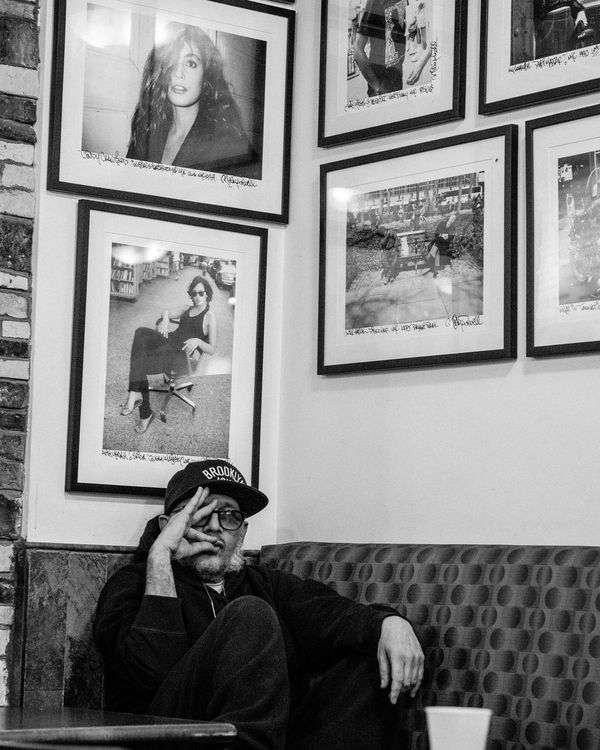[ad_1]

Ricky in Eva’s Restaurant below a number of his photographs in 2018.
Photo: Steven John Irby
In Everybody Street, Cheryl Dunn’s 2013 documentary about New York side road photographers, Ricky Powell, the downtown fixture who recorded the supernova of hip-hop in the mid-1980s, lays out the philosophical parameters of his procedure: “Man, waking up, making sure you wake up in the daytime, putting your pants on, making the calls, getting out of the house, maneuvering. You know I don’t take those for granted. I have to be prepared, because a dope shot may arise even when I just go to the deli, and it happens.”
By his personal account, Powell, who used to be discovered useless in his longtime West Village condo on Monday at age 59, turned into a well-known photographer accidentally. He used to be reward at a time in the town’s historical past now thought to be mythological: the confluence of the downtown artwork scene and uptown taste writers, the place you have to see Jean-Michel Basquiat strolling by means of your lemon-ice stand and ask him to pose for a career-making flick as he dug in his wallet for alternate. Powell wasn’t a side road photographer in the mode of Winogrand or Meyerowitz. He wasn’t overly fascinated with the balletic collision of the crowd. Nor used to be he a paparazzo, chasing down celebrities. He labored someplace in between — “the raparazzo of the Village,” he known as himself — documenting the magnificence of younger and ascendant artists and musicians and adjoining characters who in combination made up the downtown New York demimonde, bouncing from Patti Astor’s Fun Gallery to nightclubs like Danceteria and Paradise Garage, taking off-the-cuff snapshots of folks like Keith Haring, Laurence Fishburne, and Madonna after they had been simply slightly well-known, as an alternative of untouchably so.
Powell used to be a New York lifer, born in Brooklyn and raised in Greenwich Village, an alumnus of LaGuardia Community College and Hunter College, the place he gained a point in bodily training and performed on the faculty’s basketball workforce. Powell bounced round New York aimlessly after graduating, filling ordinary jobs — canine walker, change instructor, motorbike messenger, ice dealer. Aside from traveling with the Beastie Boys, he by no means left the town. For the previous 30 years he lived in a small studio condo on Charles Street in the West Village, the place he used to be a well-recognized and voluble presence, beneficiant along with his time and desperate to kibitz, his transistor radio aloft and tuned to Jazz 88.three. He might be protecting of the town, in the approach local New Yorkers have a tendency to be, and bristled at the inflow of the “New Jack cornballs” — the new cash that would make the group appear to be a Hamptons-lite.
The Beasties Boy on Charles St. in 1986.
Photo: Ricky Powell
Laurence Fishbune in Tompkins Square Park in 1987.
Photo: Ricky Powell
Debi Mazar, Sandra Bernhard, and Madonna in NYC, 1988.
Photo: Ricky Powell
He were given his get started in pictures, as is going the tale he frequently retold, out of spite. After getting dumped and discovering a Minolta his ex left at the back of, he merely resolved to take photos and develop into anyone doing it. He used to be self-trained, and lots of of his photographs betray an entire fail to remember for composition or framing or lights. But they had been no much less impressive for it, and most certainly had been higher served by means of being unburdened by means of the weight of technique. Powell’s manner used to be being there, a type of relational aesthetic for which he had uncanny skill. He described his taste as “pro photos on a hang out tip.” Within a 12 months of selecting up that first digital camera, he had parlayed a friendship with the Beastie Boys — Powell and Adam Horovitz attended P.S. 41 in the Village in combination — right into a gig documenting their excursion with Run-D.M.C.
Powell occupied a unprecedented place as a white man who used to be ready to transport inside of the in large part Black hip-hop tradition. Much of that get entry to may also be attributed to his reference to the Beastie Boys, outliers who traced a equivalent trail. But Powell possessed a definite sincerity that individuals appeared interested in, a high quality Powell himself joked he by no means totally understood. “I don’t know how I used to hang out with these dudes,” he stated in Everybody Street. “Except they knew I was down.”
“I was never sure that Ricky was white,” LL Cool J says in Ricky Powell: The Individualist, a documentary about Powell’s lifestyles set to premiere at the Tribeca Film Festival this 12 months. “I wasn’t sure if he was a light-skinned Black guy. He understood the culture, he understood the language. Ricky was the right guy at the right time.” He photographed the ones forefront artists — LL, Run-D.M.C., Public Enemy, EPMD — and the technology of fats dookie ropes and Kangol buckets at a time ahead of stylists and advertising methods, successfully shaping a lot of the common visible conception of the style. His photographs of them are fast and unfastened, the complete power and humanism of the track seized inside of the body.
Run-D.M.C. photographed by means of Ricky Powell in entrance of the Eiffel Tower.
Photo: Ricky Powell
LL Cool J in 1988.
Photo: Ricky Powell
“There are a variety of qualities that make a good street photographer,” Dunn tells Vulture. “Maybe you’re technically proficient, maybe you’re the fly on the wall, maybe, like Mary Ellen Mark would say, you have the advantage of being let in the door. Ricky would say anything to anyone — famous, non-famous. The ability to go up to anyone and just shoot the shit — he could do that, and people would be charmed by that, and he would get their picture. That was his ace quality. There are characters in those pictures, but he’s one of those characters. The people he was drawn to, he’s one of them.”
Powell used to be no longer self-serious. In his later years, he followed a glance of clever dishevelment: too-large pants pooling above his Converse All-Stars and an obnoxiously loud baseball cap with humongous embroidery, like W 4TH (for the subway station) or THE NEW YORK CRIMES (in the newspaper’s gothic font), or REAL NEW YORKER (in the mag’s), the cap at all times cocked to 1 facet, and had taken to posing for pictures with pinched hands pursed to his mouth, as though he had been puffing on a phantom joint, a pose he known as “the invisible jazz cigarette.” He referred to himself with winkingly self-deprecating nicknames like “The Lazy Hustler,” and “Uncle Sloppy,” turning into one thing of a down-tempo ambassador for the group, even every now and then main informal strolling excursions.
“He really was all about the city,” Tony Arcabascio, certainly one of the founders of the New York streetwear label Alife, who knew Powell since the mid-’90s, tells Vulture. “When we would walk around the city, he always made me feel like a tourist, as much as I grew up here. Sometimes I would pretend to know what he was talking about, just so I didn’t come off like some punk. He knew everybody. He knew every place. He knew the heavy hitters, but he also knew the homeless. For him, they were equally important. They were both worthy of presenting the city that he loved. He’d take a picture of the UPS guy the same way he would Madonna.”
Jean-Michel Basquiat and Andy Warhol on Mercer St., 1985.
Photo: Ricky Powell
Ricky Powell on the 1987 Licensed to Kill excursion with the Beastie Boys.
Photo: Courtesy of Ricky Powell
In some ways, Powell represented a model of the town that has all however light away, the an important connections made at golf equipment and galleries now muffled by means of real-estate issues or mediated by means of monitors. Powell took delight in with the ability to be offering a bridge. “He knew as well as any of us whose been around long enough that the thing about New York is it fuckin’ changes,” Arcabascio says. “I think Ricky knew that’s what he was there for — to school you and let you know what the old New York was all about, but he was also there to document the new New York.”
In interviews, Powell likened side road pictures to his ever-present transistor radio. “Well, photography, all you gotta to do is step out your house, and there will always be pictures to take,” he stated. “The playlist is infinite.”










